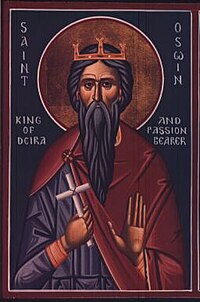Oswine of Deira
This article includes a list of references, related reading, or external links, but its sources remain unclear because it lacks inline citations. (February 2013) |
Oswine of Deira | |
|---|---|
 | |
| King, Martyr | |
| Born | Unknown |
| Died | 20 August, 651 Gilling, Yorkshire, England |
| Venerated in | Roman Catholicism, Eastern Orthodoxy, Anglican Communion |
| Major shrine | Tynemouth, England |
| Feast | 20 August |
Oswine, Oswin or Osuine (died 20 August 651) was a King of Deira in northern England.
Life
Oswine succeeded King Oswald of Northumbria, probably around the year 644, after Oswald's death at the Battle of Maserfield.[1] Oswine was the son of Osric. His succession, perhaps the choice of the people of Deira,[2] split the Kingdom of Northumbria. Oswiu was the successor of Bernicia to the north.[3]
After seven years of peaceful rule, Oswiu declared war on Oswine. Oswine refused to engage in battle, instead retreating to Gilling and the home of his friend, Earl Humwald.[4] Humwald betrayed Oswine, delivering him to Oswiu's soldiers by whom Oswine was put to death.[5]
Veneration
Oswine was buried at Tynemouth, but was later forgotten. It is said that his burial place was made known by an apparition to a monk named Edmund,[2] and his relics were translated to an honorable place in Tynemouth Priory in 1065. There was a cult of Saint Oswin as a Christian martyr because he had died "if not for the faith of Christ, at least for the justice of Christ".
St. Oswin's Church, Wylam

The Anglican Parish Church of Wylam, Northumberland, England is dedicated to Saint Oswin. The church was built in 1886 and currently has a congregation of about 150. The church has a peal of 6 bells (in the tower) and has regular Sunday services with ringing.
Our Lady & St. Oswin's Church, Tynemouth
St. Oswin is co-patron (with Our Lady) of the Catholic parish of Tynemouth with a church at the end of Front Street not far from the ruins of the priory where Oswin was buried.
References
- ^ Turner, Joseph. Ancient Bingley: Or, Bingley, Its History and Scenery. University of California Libraries. p. 34. Retrieved 5 May 2015.
- ^ a b Parker, Anselm. "St. Oswin." The Catholic Encyclopedia. Vol. 11. New York: Robert Appleton Company, 1911. 28 Mar. 2013
- ^ "St. Oswin, King of Deira (AD -AD 651)". Britannia.com. Britannia.com, LLC. Retrieved 5 May 2015.
- ^ Strutt, Joseph. From the Arrival of Julius Caesar to the End of the Saxon Heptarchy. Joseph Cooper. p. 139. Retrieved 5 May 2015.
- ^ Hutchinson, William. The History and Antiquities of the County Palatine of Durham (Volume 1 ed.). p. 9. Retrieved 5 May 2015.
Sources
- Bede, Historia Ecclesiastica gentis Anglorum, ed. and tr. B. Colgrave and R.A.B. Mynors, Bede’s Ecclesiastical History of the English People. Oxford, 1969.
- Anonymous, Vita Oswini (twelfth century), ed. James Raine, Miscellanea Biographica. Publications of the Surtees Society 8. London, 1858. 1-59. PDF available from Internet Archive.
Further reading
- Chase, Colin. "Beowulf, Bede, and St. Oswine: The Hero's Pride in Old English Hagiography." The Anglo-Saxons. Synthesis and Achievement, ed. J. Douglas Woods and David A.E. Pelteret. Waterloo (Ontario), 1985. 37-48. Reprinted in The Beowulf Reader, ed. Peter S. Baker. New York and London, 2000. 181-93.
